Fluorinated Polyimide-Film Based Temperature and Humidity Sensor Utilizing Fiber Bragg Grating
Abstract
:1. Introduction
2. Materials and Methods
2.1. Functional Material
2.2. Sensor Structure
2.3. Working Principles
3. Results
4. Conclusions
Author Contributions
Funding
Acknowledgments
Conflicts of Interest
References
- Farahani, H.; Wagiran, R.; Hamidon, M.N. Humidity Sensors Principle, Mechanism, and Fabrication Technologies: A Comprehensive Review. Sensors 2014, 14, 7881–7939. [Google Scholar]
- Sikarwar, S.; Yadav, B.C. Opto-electronic humidity sensor: A review. Sens. Actuators A Phys. 2015, 233, 54–70. [Google Scholar]
- Lo Presti, D.; Massaroni, C.; Schena, E. Optical Fiber Gratings for Humidity Measurements: A Review. IEEE Sens. J. 2018, 18, 9065–9074. [Google Scholar]
- Kapic, A.; Tsirou, A.; Verdini, P.G.; Carrara, S. Humidity Sensors for High Energy Physics Applications: A Review. IEEE Sens. J. 2020, 20, 10335–10344. [Google Scholar]
- McDonagh, C.; Burke, C.S.; MacCraith, B.D. Optical chemical sensors. Chem. Rev. 2008, 108, 400–422. [Google Scholar]
- Lee, B. Review of the present status of optical fiber sensors. Opt. Fiber Technol. 2003, 9, 57–79. [Google Scholar]
- Arregui, F.J.; Matias, I.R.; Cooper, K.L.; Claus, R.O. Simultaneous measurement of humidity and temperature by combining a reflective intensity-based optical fiber sensor and a fiber Bragg grating. Sens. J. IEEE 2002, 2, 482–487. [Google Scholar] [CrossRef]
- Bariáin, C.; Matίas, I.R.; Arregui, F.J.; López-Amo, M. Optical fiber humidity sensor based on a tapered fiber coated with agarose gel. Sens. Actuators B Chem. 2000, 69, 127–131. [Google Scholar]
- Khijwania, S.K.; Srinivasan, K.L.; Singh, J.P. An evanescent-wave optical fiber relative humidity sensor with enhanced sensitivity. Sens. Actuators B Chem. 2005, 104, 217–222. [Google Scholar]
- Gastόn, A.; Pérez, F.; Sevilla, J. Optical fiber relative-humidity sensor with polyvinyl alcohol film. Appl. Opt. 2004, 43, 4127–4132. [Google Scholar] [CrossRef] [PubMed]
- Zhang, L.; Gu, F.; Lou, J.; Yin, X.; Tong, L. Fast detection of humidity with a subwavelength-diameter fiber taper coated with gelatin film. Opt. Express 2008, 16, 13349–13353. [Google Scholar] [CrossRef] [PubMed]
- Li, T.; Dong, X.; Chan, C.C.; Ni, K.; Zhang, S.; Shum, P.P. Humidity Sensor With a PVA-Coated Photonic Crystal Fiber Interferometer. IEEE Sens. J. 2013, 13, 2214–2216. [Google Scholar] [CrossRef]
- Dong, X.; Li, T.; Liu, Y.; Li, Y.; Zhao, C.; Chan, C.C. Polyvinyl alcohol-coated hybrid fiber grating for relative humidity sensing. J. Biomed. Opt. 2011, 16, 1–5. [Google Scholar] [CrossRef] [PubMed]
- Oliveira, R.; Bilro, L.; Marques, T.H.R.; Cordeiro, C.M.B.; Nogueira, R. Simultaneous detection of humidity and temperature through an adhesive based Fabry–Pérot cavity combined with polymer fiber Bragg grating. Opt. Lasers Eng. 2019, 114, 37–43. [Google Scholar] [CrossRef]
- Shao, M.; Zang, Y.; Qiao, X.; Fu, H.; Jia, Z.-A. Humidity Sensor Based on Hybrid Fiber Bragg Grating/Abrupt Fiber Taper. IEEE Sens. J. 2017, 17, 1302–1305. [Google Scholar] [CrossRef]
- Lewis, E.; Hernandez, F.U.; Correia, R.; Morgan, S.P.; Hayes-Gill, B.; Evans, D.; Sinha, R.; Norris, A.; Harvey, D.; Hardman, J.G.; et al. Simultaneous temperature and humidity measurements in a mechanical ventilator using an optical fibre sensor. In Sixth European Workshop on Optical Fibre Sensors; International Society for Optics and Photonics, SPIE: Bellingham, WA, USA, 2016. [Google Scholar] [CrossRef]
- Jiang, B.; Bi, Z.; Hao, Z.; Yuan, Q.; Feng, D.; Zhou, K.; Zhang, L.; Gan, X.; Zhao, J. Graphene oxide-deposited tilted fiber grating for ultrafast humidity sensing and human breath monitoring. Sens. Actuators B Chem. 2019, 293, 336–341. [Google Scholar] [CrossRef]
- Villatoro, J.; Zubia, J.; Schuster, K.; Arregui, F.J.; Elosua, C. Enhancing sensitivity of photonic crystal fiber interferometric humidity sensor by the thickness of SnO2 thin films. Sens. Actuators B. Chem. 2017. [Google Scholar] [CrossRef]
- Mohamed, H.; Irawati, N.; Ahmad, F.; Ibrahim, M.H.; Harun, S.W. Optical Humidity Sensor Based on Tapered Fiber with Multi-walled Carbon Nanotubes Slurry. Indones. J. Electr. Eng. Comput. Sci. 2017, 6, 97–103. [Google Scholar] [CrossRef]
- Massaroni, C.; Caponero, M.A.; D’Amato, R.; Lo Presti, D.; Schena, E. Fiber Bragg Grating Measuring System for Simultaneous Monitoring of Temperature and Humidity in Mechanical Ventilation. Sensors 2017, 17, 749. [Google Scholar] [CrossRef]
- Giaccari, P.; Limberger, H.G.; Kronenberg, P. In Influence of humidity and temperature on polyimide-coated fiber Bragg gratings. In Bragg Gratings, Photosensitivity, and Poling in Glass Waveguides; Optical Society of America: Washington, DC, USA, 2001. [Google Scholar] [CrossRef]
- Kronenberg, P.; Rastogi, P.K.; Giaccari, P.; Limberger, H.G. Relative humidity sensor with optical fiber Bragg gratings. Opt. Lett. 2002, 27, 1385–1387. [Google Scholar] [CrossRef]
- Yeo, T.L.; Sun, T.; Grattan, K.T.V.; Parry, D.; Lade, R.; Powell, B.D. Characterisation of a polymer-coated fibre Bragg grating sensor for relative humidity sensing. Sens. Actuators B Chem. 2005, 110, 148–156. [Google Scholar] [CrossRef]
- Sidhu, N.K.; Sohi, P.A.; Kahrizi, M. Polymer based optical humidity and temperature sensor. J. Mater. Sci. Mater. Electron. 2019, 30, 3069–3077. [Google Scholar] [CrossRef]
- Xie, Z.; Yan, H.; Li, Y.; Zhao, X. A humidity fiber sensor based on both end-sides of a fiber Bragg grating coated with polyimide. Opt. Fiber Technol. 2020, 57. [Google Scholar] [CrossRef]
- Zhao, X.; Liu, J.; Rui, J.; Fan, L.; Yang, S. Synthesis and characterization of organosoluble polyfluorinated polyimides derived from 3,3′,5,5′-tetrafluoro-4,4′-diaminodiphenylmethane and various aromatic dianhydrides. J. Appl. Polym. Sci. 2010, 103, 1442–1449. [Google Scholar] [CrossRef]
- Huo, H.; Mo, S.; Sun, H.; Yang, S.; Fan, L. Preparation and properties of molecular-weight-controlled polyimide adhesive film. e-Polymers 2012, 12, 566–583. [Google Scholar] [CrossRef]

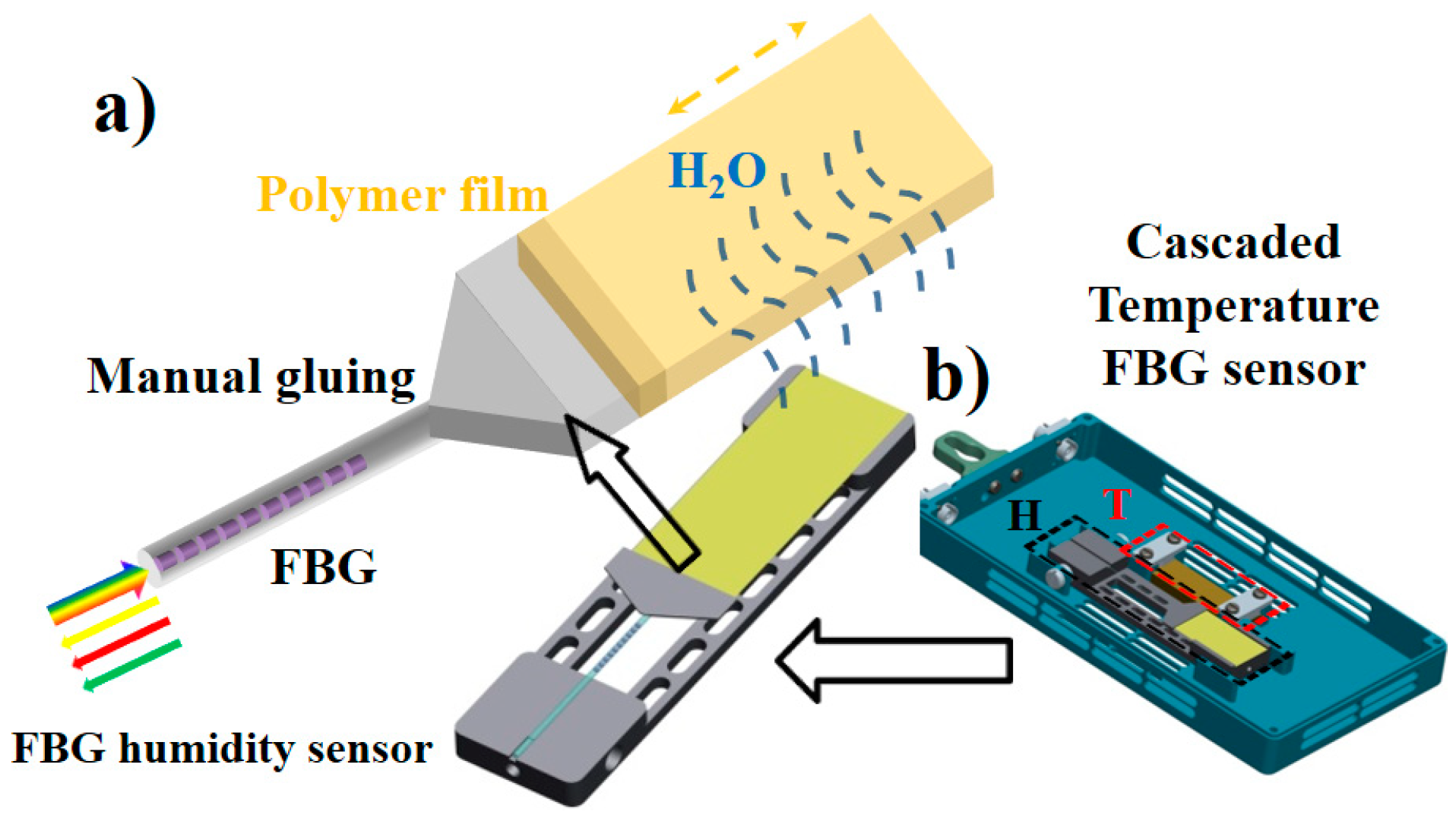
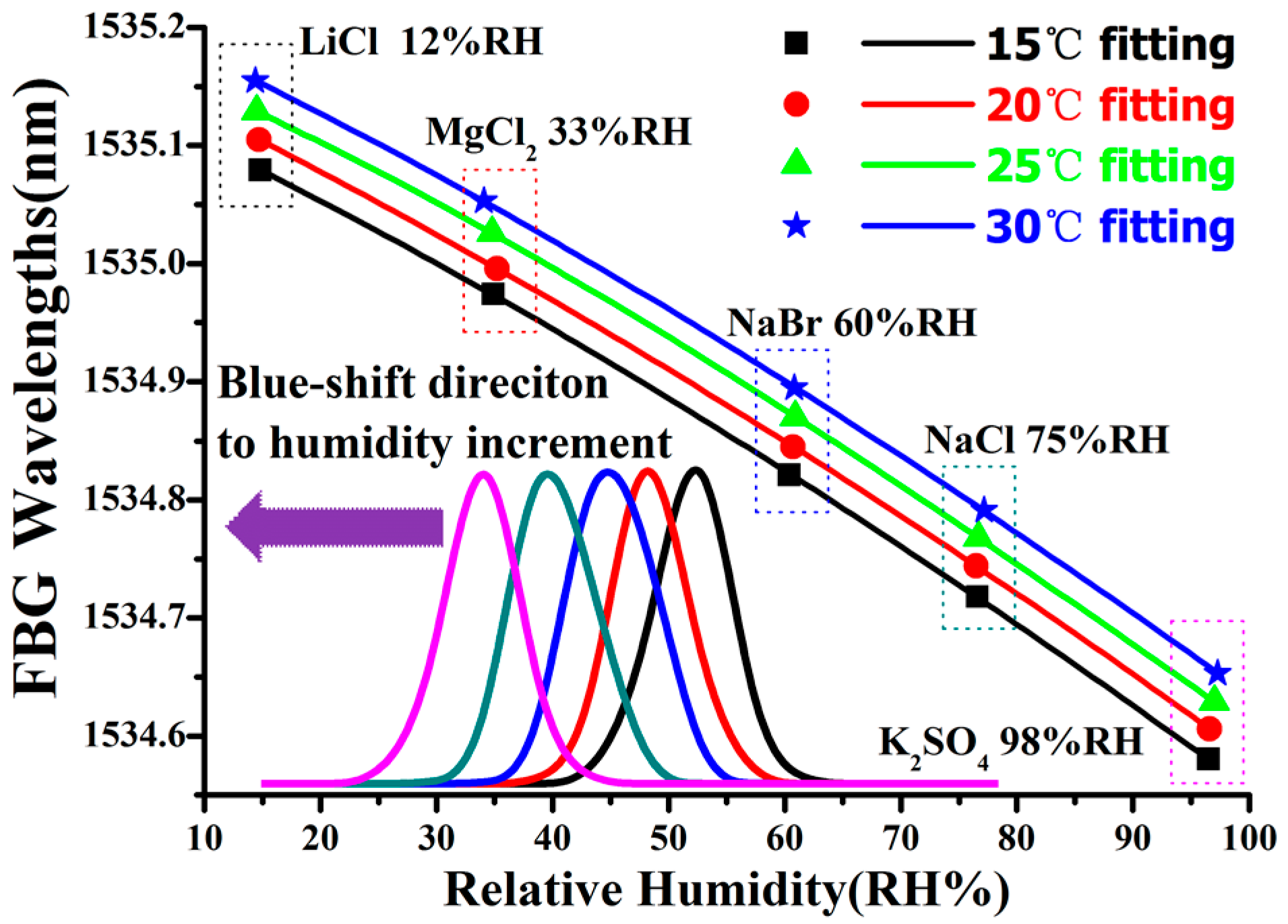


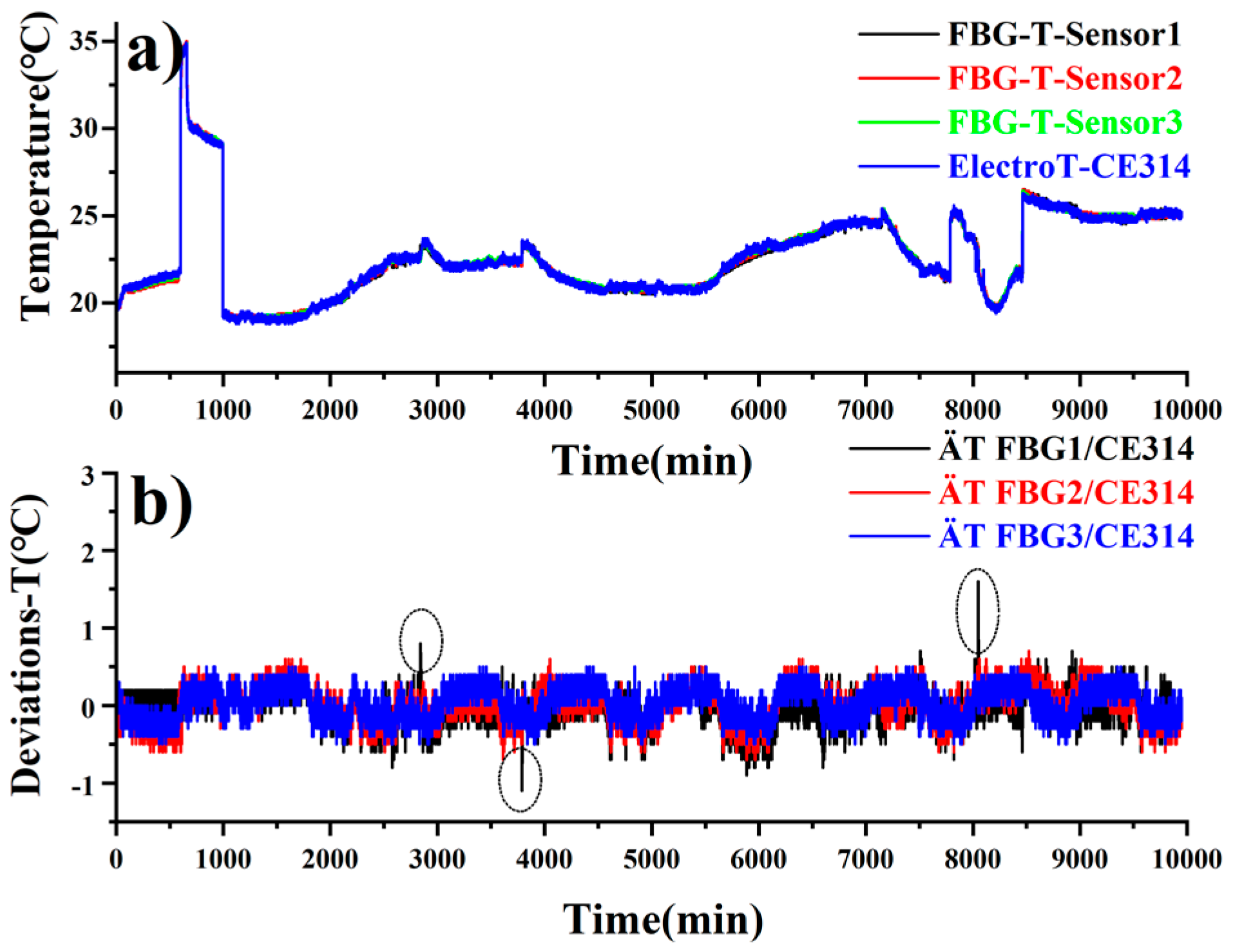
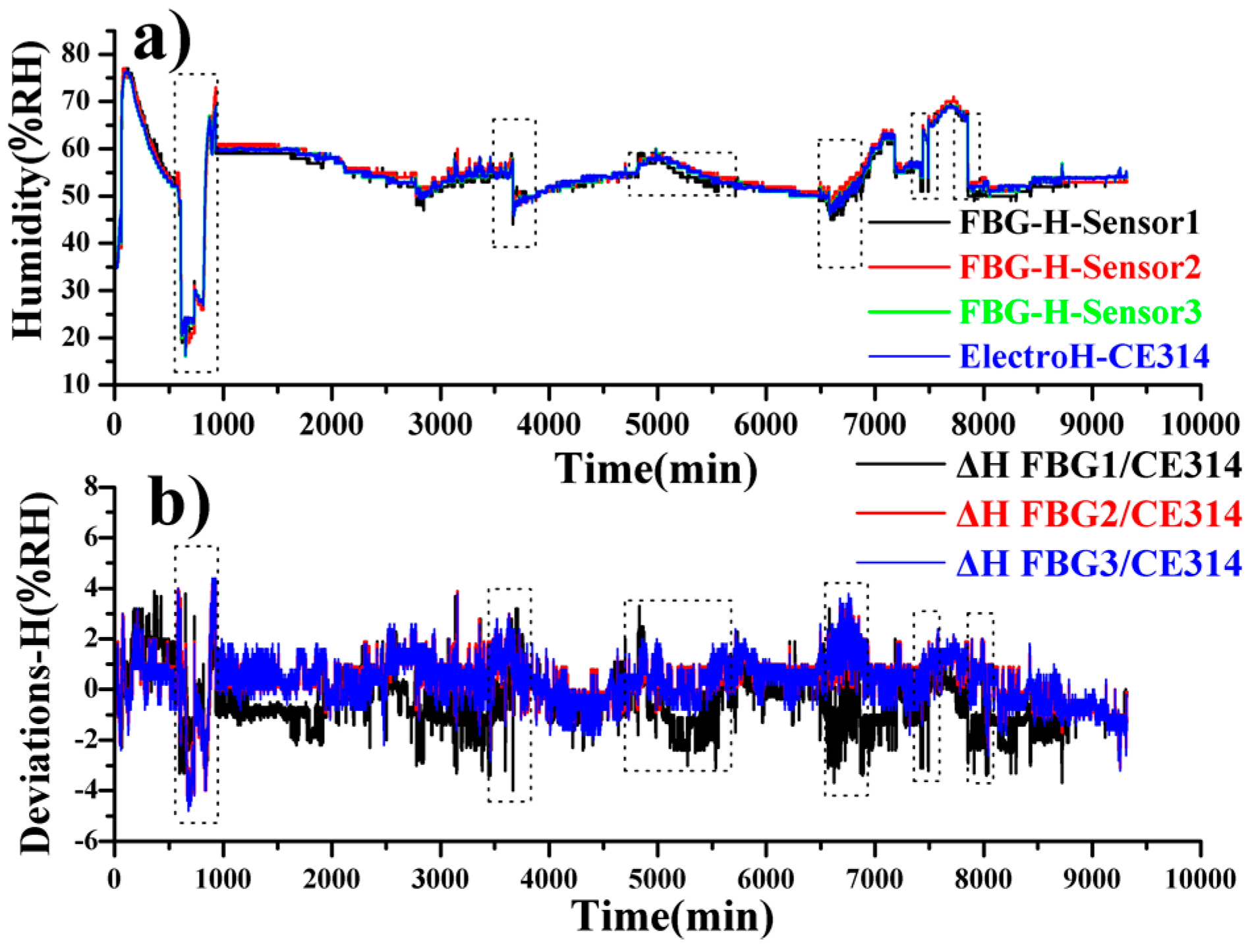
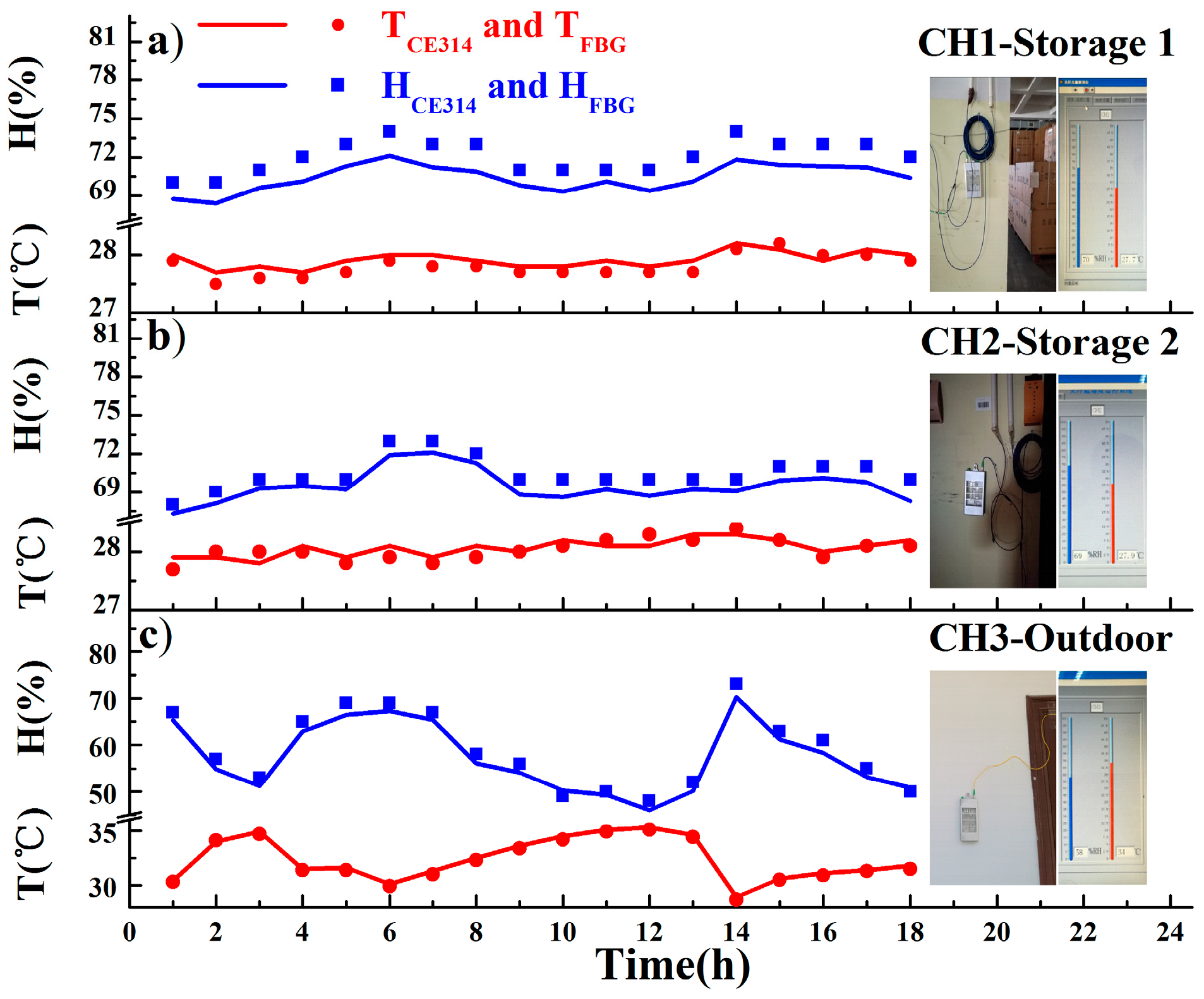
© 2020 by the authors. Licensee MDPI, Basel, Switzerland. This article is an open access article distributed under the terms and conditions of the Creative Commons Attribution (CC BY) license (http://creativecommons.org/licenses/by/4.0/).
Share and Cite
Xu, X.; Luo, M.; Liu, J.; Luan, N. Fluorinated Polyimide-Film Based Temperature and Humidity Sensor Utilizing Fiber Bragg Grating. Sensors 2020, 20, 5469. https://doi.org/10.3390/s20195469
Xu X, Luo M, Liu J, Luan N. Fluorinated Polyimide-Film Based Temperature and Humidity Sensor Utilizing Fiber Bragg Grating. Sensors. 2020; 20(19):5469. https://doi.org/10.3390/s20195469
Chicago/Turabian StyleXu, Xiuxiu, Mingming Luo, Jianfei Liu, and Nannan Luan. 2020. "Fluorinated Polyimide-Film Based Temperature and Humidity Sensor Utilizing Fiber Bragg Grating" Sensors 20, no. 19: 5469. https://doi.org/10.3390/s20195469




